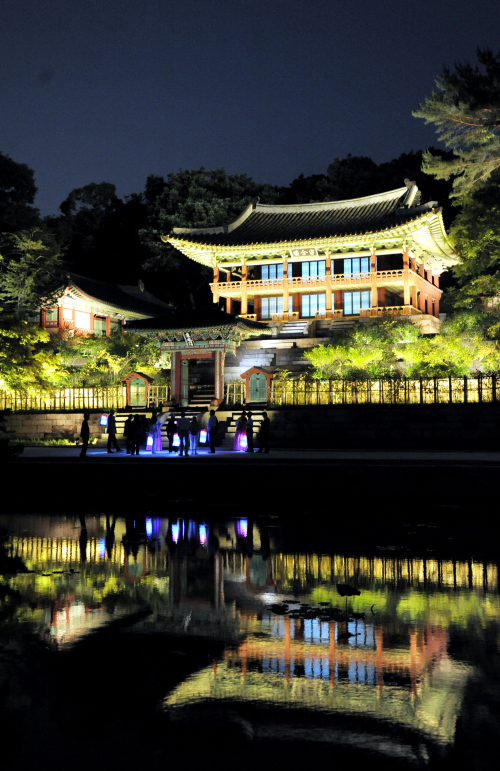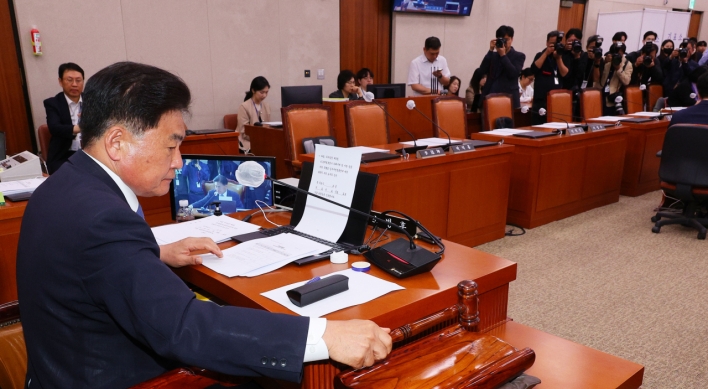Changdeokgung Moonlight Trail invites visitors to a mystical journey crossing past and present
Under the soft moonlight, every wooden building, tree and pond in the palace seemed to unfold at least twice as many stories hidden in every nook and corner than they would in the daytime.
The Moonlight Trail of Changdeokgung in Waryong-dong, central Seoul, began at 8 p.m. on Tuesday when the long summer day still lingered and the almost-full moon was still pale. But it did not take long for the UNESCO World Heritage site to unveil its quaint beauty as it went deeper into the night and the moon gradually lightened in bright gold. The harmony of the palace and the surrounding nature was exceptional.
The evening’s two-hour tour was hosted by the Korea Tourism Organization to promote the tourism program organized by the Cultural Heritage Administration. Hoping to show a new face of the royal palace, the Administration tried out the event last year and officially started it in April.
Under the soft moonlight, every wooden building, tree and pond in the palace seemed to unfold at least twice as many stories hidden in every nook and corner than they would in the daytime.
The Moonlight Trail of Changdeokgung in Waryong-dong, central Seoul, began at 8 p.m. on Tuesday when the long summer day still lingered and the almost-full moon was still pale. But it did not take long for the UNESCO World Heritage site to unveil its quaint beauty as it went deeper into the night and the moon gradually lightened in bright gold. The harmony of the palace and the surrounding nature was exceptional.
The evening’s two-hour tour was hosted by the Korea Tourism Organization to promote the tourism program organized by the Cultural Heritage Administration. Hoping to show a new face of the royal palace, the Administration tried out the event last year and officially started it in April.

“The palace at night is a beauty, as you can see, although we can’t open it at night due to security reasons. So we came up with ‘Changdeokgung Moonlight Trail’ to host visitors on the few nights of full moon. People tend to think of liquor or food at the mention of nightlife in Seoul, but we wanted to show that we have this classic side as well,” Choe Kwang-shik, administrator of Cultural Heritage Administration, told The Korea Herald. On other days, the palace opens until 6 p.m.
About 70 ambassadors, VIPs and members of the press gathered at Donhwamun, Changdeokgung’s main gate. Among the guests were Korea Tourism Organization president Lee Charm, U.S. ambassador Kathleen Stephens and Lee Won, grandson of Gojong, the second to last emperor of the Joseon Dynasty, who is currently the chairman of the Korean Monarchy Culture Institute.
“Mr. Lee would have been strolling around here as King if it had been like the old days, but time has changed. Now he is here just like the rest of us, joining the tour,” said Lee Bae-yong, chairwoman of the Presidential Council on Nation Branding who guided group A, jokingly.
Indeed, time has passed. The palace at night, however, seemed to have stopped in time ― as if its residents were not gone forever but were just having a good night’s sleep behind the glowing windows.
Changdeokgung, one of the five grand palaces in Seoul, was built in 1405 during the reign of Taejong, the third king of the Joseon Dynasty. It was designated as UNESCO’s world heritage site in 1997, valued highly for its harmony of nature and the palace which portrayed Confucianism and Koreans’ traditional spirit of not going against the laws of nature.
Lee led the group on a journey back in history, reminding us how busy and crowded the place was and how thoughtful the ancestors must have been.
“Now the trees and stones here tell us. A stream always flowed near the entrance of the palace because your spirit has to be pure and fair to engage in politics. Under the bridge there are two sculptures ― the turtle hinders bad spirits from entering the palace and the haetae symbolizes the ability to know what is right or wrong. This is something politicians who are here with us today should bear in mind,” she said, stopping at Geumcheongyo, the first bridge that the group came across after entering the Donhwamun and passing lines of locust trees.
The group passed Jinseonmun, a smaller gate, and continued the tour to Injeongjeon, the center of the palace where the king managed political affairs. Of every stone road leading up to the building, the center part was slightly elevated. This was where only the king could step, said Lee.
The ground still had the air of power struggles and hierarchy. Stones engraved with the ranks of the officials were lined up from high to low starting from near Injeongjeon. Military nobilities were to sit on the left and civil functionaries on the right. Iron rings were installed in the yard to put up an awning when needed, but in the spot where it could only cover some of the highest officials.
The eastern part of the palace including Nakseonjae, where the queens, young princes and court ladies peacefully resided, was a world apart from the political Injeongjeon. It could not be any more delicate and feminine ― every eave and window frame showed a different pattern from bats and turtles to lace-like trims. Lights glowing out of the windows accented the decorations.
On the fireplace were patterns reminiscent of ice breakings. It reflects their wish to put out any fire; a wish based on anxiety of living in wooden buildings, explained Lee. The repetitive hexagons on the walls symbolized perpetual prosperity of the kingdom. Kings’ mothers and grandmothers spent long hours praying under it.
The palace, however, was not always so caring and loving. Close to Nakseonjae is Chuiseondang where the royal concubine Jang tried to put a voodoo curse on Queen Inhyeon in the late 1600s, attempting to dethrone her, said Lee.
From Nakseonjae, it took a good 15 minutes to reach Buyongji, a pond with lotus flowers situated deep inside the palace. The palace overall had minimum artificial light so visitors strolled down a forest walk in pitch black. Women decked in fine hanbok carried “cheongsachorong,” or a traditional Korean lantern with a red and blue silk shade, to dot the trail with lights.
Lights suddenly flooded upon approaching Buyongji. Then came a picturesque view of the illuminated Gyujanggak (royal library built during Joseon Dynasty’s 22nd King Jeongjo’s reign) and its reflection in the pond and the simple Buyongjeong (a pavilion for reading books) dipping two of its legs in the water. The sentimental melody of “gayageum,” a Korean traditional musical instrument which a musician was playing on Yeonghwadang (a pavilion which was used as a venue for exams), added to the beauty.
“I have been here several times but this is the first time I visited at night. The artistry of the buildings really stands out in the nighttime. I can easily imagine what it must have been to live here ― beautiful,” said the U.S. ambassador.
Fiona Uden, wife of British ambassador Martin Uden, excitedly snapped photos with her digital camera the whole time. This was also her first visit at night although she had visited the palace several times already.
“It is just magical. Changdeokgung is the best palace because I can always go on a guided tour. When you are wandering around Gyeongbok Palace, you miss a lot of the wonderful details,” she said and ran off to listen as Lee started to explain about a rock.
“See, would you have known these stones are toads? I feel like I’m a sponge right now, absorbing all of it,” she said happily, coming back to talk to The Korea Herald as Lee wrapped up the tour.
A small performance of gayageum and dageum, both Korean traditional musical instruments, accompanied by delicious Korean snacks at Yeongyeongdang highlighted the end of the program. It was an extraordinary experience indeed ― after all, what other setting could be more fitting to enjoy Korean traditional music?
“We recently opened Gyeongbokgung at night for a week and the reception was great. The program at Changdeokgung will continue every year, and the same program for Gyeongbokgung is under discussion as well,” said Choe.
The next Changdeokgung Moonlight Trail will be in September, as the event is not held in summer and winter seasons due to weather conditions. The program will be held for Koreans on Sept. 12 and Oct. 11-12; and for foreigners on Sept. 13 and Oct. 8 through 10. Tours are available in Korean, English, Chinese and Japanese. Reservations start 20 days before the event. Admission is 30,000 won.
A maximum of 10 additional programs per year can be run if a team of 50 to 100 wishes to join the tour on other dates. It costs 10 million won for a team of 100. For more information, call (02) 3011-2153 or visit www.chf.or.kr.
By Park Min-young (claire@heraldcorp.com)










![[Kim Seong-kon] Democracy and the future of South Korea](http://res.heraldm.com/phpwas/restmb_idxmake.php?idx=644&simg=/content/image/2024/04/16/20240416050802_0.jpg&u=)







![[Today’s K-pop] Zico drops snippet of collaboration with Jennie](http://res.heraldm.com/phpwas/restmb_idxmake.php?idx=642&simg=/content/image/2024/04/18/20240418050702_0.jpg&u=)